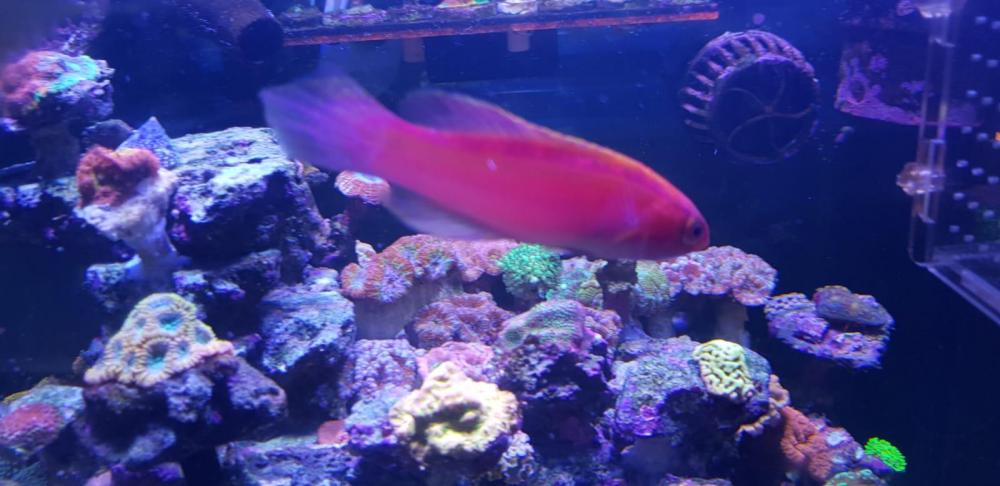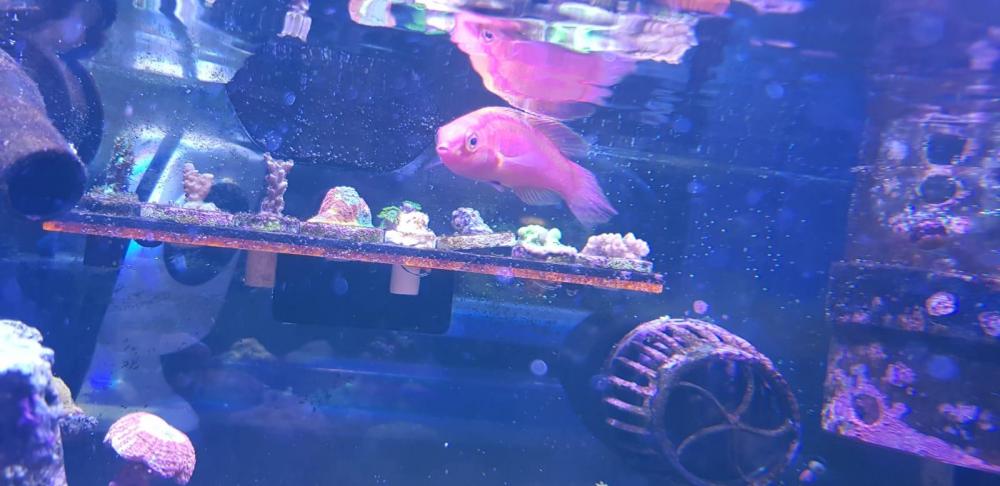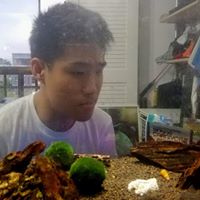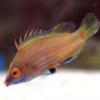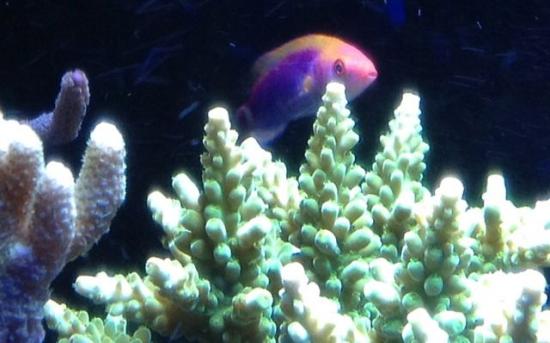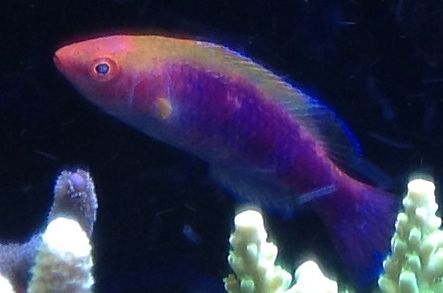Search the Community
Showing results for tags 'wrasse'.
-
Feeding mainly on pellets & fish frenzy once awhile. Letting go @ 220, still inside tank. Will catch it upon confirmation. Collection @ Bukit Panjang WhatsApp @ 9eigth45eight255
-
Nice article about wrasse - hope will be useful for beginners... Source: http://www.3reef.com/threads/all-about-reef-safe-wrasses.122261/ Introduction So being a self-proclaimed wrasse freak, I am taking it upon myself to sum up my knowledge and experience about keeping wrasses as best as I can. I have such a love and passion for these fish, I can’t imagine keeping a reef without one or two or ten. I’m hopeful this thread will be seeing a continual evolution, and I would also like to open it up to “all things wrasse” as well as keep it flowing with advice/Q&A. For now, I wish to proceed with attempting to capture all I know about keeping these beautiful, fascinating fish, including: what is a reef safe wrasse, general requirements, feeding, the different genera which are reef safe and appropriate caveats with each, mixing various genera and different species of the same genus, and lastly listing the more popular species within each genus and some comments on each. What’s a Reef Safe Wrasse? First, let’s discuss what qualifies as a reef safe wrasse. I consider three big breaks in the entire wrasse family which are as follows: 1) Completely reef safe, 2) Mostly reef safe, and 3) Don’t even think about it. I am only going to focus on wrasses in categories 1 and 2 for a few reasons, but mainly because the entire classification of wrasses is so large, this thread could literally be my life’s work if I didn’t scope it back accordingly. It is very true there are some wrasses in the third category that some experienced reefers keep in their reef tanks, but they are well aware of what special measures are required for such to be possible. Wrasses in category 1 do not pose any risk to your coral or decorate/useful invertebrates. Wrasses in category 2 also do not pose any risk to your coral, but may pose some risk to certain invertebrates. However, this risk is greatly minimized if you follow the guidelines in this thread, mainly the general guidelines listed below. A general note about all reef-safe wrasses: they can ship poorly, and all are easily stressed, especially during system transitions. You must be vigilant when adding a wrasse to a system and when adding new arrivals. Please give a newly added wrasse time to adjust to their new system, up to a week or two. DO NOT go disturbing your tank looking for them; this will only add stress and hurt your chances of success. This especially applies to the sand burrowing genera; don’t go dig them up just to see them. General Requirements The three big requirements for keeping wrasses, which I cannot stress enough, are: • Must be kept with appropriate tankmates. Basically, no “aggressive” fish. You need to have a relatively peaceful tank in order for it to be suitable for reef safe wrasses. • They need to be feed several times per day. If the thought of supplying small amounts of food (nutrients) to your tank several times per day makes you cringe, look elsewhere. Wrasses are very active fish, and need a variety of meaty foods often in their diet to keep them healthy. • Must be kept IN A COVERED TANK. This is fundamentally essential. All wrasses are jumpers. They are a deep water fish and are not instinctually used to the surface being so near to them. Keep them in an uncovered tank, or one with any gaps, and it is simply a matter of time before they go carpet surfing. On that note, a 5/8” wrasse will fit though a 5/8” hole. Don’t leave any opportunities for escape. If the head fits, the fish fits! Lastly, these points should go without saying, but I hate for them to go without consideration. You need to check the individual requirements of each species before you determine if a specific one is good for you. They all have their own requirements. Notably, please make sure you house them in an appropriate sized tank. Feeding Wrasses should be fed small amounts of meaty foods ~3 times per day. Offer a variety of foods. Personally, I feed a frozen meaty food twice per day and pellets for another feeding each day (I even offer nori once a week; some species will show interest, others will not). Feed small amounts dispersed throughout the tank in effort to ensure each fish gets their share, while limiting the amount to prevent excessive nutrients. Rinsing some frozen foods can help a little in the latter department. A good skimmer is a must with a wrasse-dominant system. Genera which are “Reef Safe” There are eight(ish) genera of wrasses which are considered to be reef safe and are commonly available in the trade. They are: Anampses, Cirrhilabrus, Halichoeres, Labroides, Macropharyngodon, Paracheilinus, Pseudocheilinus, Wetmorella, and one offshoot of Pseudocheilinus: Pseudocheilinops (with a single species; see the species list by genus section). Anampses: Often referred to as “Tamarin” wrasses, species of this genus are not for the inexperienced keeper. While this genus can be hardy if healthy and established in a system, achieving such is generally not a simple task. This genus stresses very easily in transit, and often ships quite poorly. They are also prone to injury upon collection. If you find a specimen for sale of this genus and must have it, inspect the mouth/jaws carefully and insure there is no signs of injury. I would also recommend insuring the specimen is accepting prepared foods when offered. Lastly, a sandbed is a requirement for this genus, as they will bury at night or when frightened. Cirrhilabrus: The crown jewel genus. Beautiful, peaceful (usually), very active, and smart, these often come with a great personality as well. These are the “Fairy” wrasses. Generally hardy, but like most wrasse genera these are also prone to shipping stress. So long as they will be entering a suitable system with compatible tankmates, this isn’t much of a concern with this genus however. Cirrhilabrus wrasses take to prepared foods very easily, and are voracious eaters. If a specimen is not eating, health concerns are certainly justified. Males are much more colorful than females for any given species within this genus. Cirrhilabrus wrasses, like most genera here, are protogynous hermaphrodites, meaning females transition to male in the wild as harem conditions and space require. Females can/may transition to male in a closed system as well, which often occurs if kept in the presence of other Cirrhilabrus wrasses of a different species in the same system. Females may be kept together with a single male of one species in the same system, but there is no guarantee a female will stay female. Mated relationships between wrasses are like that of Anthias, in that sex is maintained by a dominance/submissive hierarchical order. Species in this genus do not need a sandbed, as they will sleep within the rockwork in a mucus cocoon. Halichoeres: A very large genus with a wide variety of species (over 75). Only a handful of particular species are commonly offered in the trade however. Most of the ones which enter the trade fall into category 2 on the “reef safe” scale. Some however, fall into category 3 as they readily consume inverts. Those in category 2 usually do not pose a significant risk to inverts if they are feed properly. I do not hesitate to keep some wrasses of this genus in my personal reef. This genus readily accepts prepared foods and will also spend most of the day searching for food amongst the rockwork and sandbed in a tank. They will often consume ‘pods and various pests. A sandbed is a requirement for this genus, as they will bury at night or when frightened. Labroides: I hesitate to even include this genus, as I big reservations against even buying them, let alone keeping them or recommending them for a reef tank. These are the “cleaner” wrasses, as in the wild they remove parasites and dead scales/tissue from other reef fish. My reservations against buying/keeping this genus are due to the following two reasons: they cannot be sustained long term in a closed system as a diet of prepared foods does not offer them the range of nutrition they require, and mostly the mere collection of this species impacts the overall health of a wild reef. There are a few success stories about keeping a cleaner wrasse long term, but for each success there are hundreds of failures. Please leave this fish in the ocean where it’s best suited. If the demand for sales of these species would cease, so would their wild collection. Macropharyngodon: The “Leopard” wrasses. A very delicate genus, they are exceptionally prone to shipping and collection stress. These are not for the inexperienced keeper. They can also be difficult to wean onto prepared foods. Specimens for purchase should be well inspected for any trauma and ensure they are accepting prepared foods. Make sure they are actually swallowing prepared foods, as often they will spit them back out before this change in diet has been accepted. Even if a specimen is healthy and eating well, the species in this genus easily stress upon any move from one system to another. They are also quite prone to flukes and treatment with Prazi upon purchase is recommended. Once added to a new system, it is not uncommon from them to disappear in the sandbed for a week (or even up to two). Let them be. You will see them again in a few days if all goes well. Do not go dig them up. A sandbed is a requirement for this genus, as they will bury at night or when frightened. Paracheilinus: The “Flasher” wrasses. A very active genus with several colorful species, in many ways these are quite similar to the Cirrhilabrus genus except they remain much smaller. The common name arises naturally from the male’s behavior of “flashing”, either for territorial display or courting, where the dorsal and anal fins are erected and blood rushes to the scales, resulting in quite the display of color and posture. This is a generally hardy genus, but like the others is prone to shipping stress. However, like the Cirrhilabrus genus, this is not much concern if they are bound for an appropriate system. They are voracious eaters and take to prepared foods easily. There is also quite the discernable difference between male and females of the same species. Females are not nearly as common in the trade as divers do not often collect them due to their dull coloration in contrast to the males. Species in this genus do not need a sandbed, as they will sleep within the rockwork in a mucus cocoon. Pseudocheilinus: The “Lined” wrasses, such as the Sixline, Fourline, etc, but also include such species as the Mystery Wrasse. Once established in a system, they often become quite pugnacious towards new additions and are outright incompatible with other wrasses. For this reason, I prefer to avoid this genus and find myself to be not very fond of them; however they do hold some merit in the hobby as they can be a great addition in the appropriate setting. This is a very hardy genus and will readily hunt for ‘pods and pests throughout the system. Therefore, they are a great addition to frag tanks or other small systems which are not suited for the larger genera. As much of a bully as they generally are, they are also notorious for being shy when observers are around. Species in this genus do not need a sandbed, as they will sleep within the rockwork in a mucus cocoon. Wetmorella: The “Possum” wrasses. A very shy and docile genus, they can be a bit cryptic at times in a system. They do not often exceed three inches and are one of the few genus well suited for the popular 30ish gallon cube systems. Pair only with appropriate tankmates, as a Wetmorella species which is picked on will lead to its demise. Mixing Different Species, of the Same and Different Genus Mixing wrasses of different species or genus is generally possible. While there is no exact science to this, there are certainly some guidelines. Please bear in mind, even with these guidelines, results when mixing wrasses will be variable and a conscious aquarist should be mindful of this and keep a close eye on a system with mixed species to observe for any problematic aggression. What's problematic aggression you ask? This should be defined as any chasing which results in attack or nipping, or one wrasse constantly pushing another into hiding. It is entirely normal to see some occasional (brief) chasing and very normal to see some flashing between two wrasses.; the later of which is one of the positive benefits of keeping different species together, as the Fairy and Flasher wrasses are most stunning while performing this act. Two exceptions which should be noted first: Various species of wrasses of the genus Pseudocheilinus should not be mixed in the same system, unless it’s several hundred gallons. Also, caution should be expressed when mixing various species within the Macropharyngodon genus. This can usually be done with acceptable results, but sometimes can be problematic. Close observation is required. The bigger your tank, the more likely you’ll be at success here. The one rule to never violate is keeping two dominant males of the same species together. This might work for a while, but surely will not end well. Furthermore, unless you are an experienced keeper, I would not advise two males of the same species together. While it is possible to have a dominant and sub-dominant male in the same system, please don’t give it a try unless you know what you’re doing. Males of different species can be kept together, within the same genus (there’s a few species/species combination exceptions) or between different genera. The system must be large enough however, say at least 100 gallons or so. Females of any species/genus will almost always mix just fine. A pair/trio/etc of one species may also be kept with the same of another species, and often works quite well as the males will be too pre-occupied with the conspecific females to pay attention to much else. However, as I said before, there is no guarantee a female will stay female, and may transition to male for various reasons. Sometimes this now sub-dominant male will “work things out” with the dominant male, other times they will not and you’ll end up one less fish. Again, an observant aquarist is required and one should intervene when necessary. When adding new wrasses to a system already containing established wrasses, an acclimation box is a must. Place the new arrivals in the box for 2-3 days before releasing. During this time, observe the interaction between the new arrivals and the established tankmates. If aggressive behavior is witnessed and does not subside, you had best rethink the release of the new additions. You may want to extend the acclimation period (say 4-5 days) and observe if the behavior subsides or changes. Generally, the acclimation box gives everyone enough time to “size each other up”, and much potentially aggression is avoided as the hierarchy becomes established through visual interaction. There are a few options for acclimation boxes currently on the market. Elite Aquatics offers two different sizes (I prefer the larger): http://www.elite-aquatics.net/index.php?route=product/category&path=43 Also, the AccliMate by Reef Gently would work for the purpose. While pricer, it does offer additional functionality, and may make an efficient fish trap if you need to remove an established fish later down the road for various reasons: (direct: http://reef-gently.com via Marine Depot:http://www.marinedepot.com/Reef_Gen...Aquariums-Reef_Gently-RG1111-FIMIATTK-vi.html). List of Popular Species (by Genus) Available in the USA Anampses A. caeruleopunctatus “Blue Spotted Tamarin”: Occasionally available & affordable, but does reach quite a large size (16"). Mature adults are very different in appearance from the juvi's sometimes for sale. A. chrysocephalus “Red Tail Tamarin” (female) or “Psych-Head Tamarin” (male): Likely the most popular species of this genus, and can fair well if you pick according to the aforementioned guidelines. Females adapt to captivity better than males. A. femininus “Blue-Striped Tamarin”: Absolutely stunning, with an equally stunning price tag, when rarely available A. lennardi “Lennardi Wrasse” or “Blue and Yellow Wrasse”: Almost as beautiful as the A. femininus, but has a more broken pattern. This is cooler water fish, and will not do well above 76F. At this time, long term success with this fish has been non-existent. May require an even cooler environment. A. meleagrides “Yellow-tail Tamarin”: Very similar to the Red-Tail Tamarin, just with a yellow tail. Same comments apply. A. neoguinaicus “Black-Backed Tamarin”: Rarely available, as it's a poor intercontinental shipper. But when available, and in good health, can be a great addition. A. twistii “Yellow-Breasted Tamarin”: Often available and affordable. One of the smallest Anampses, but can sometimes be a bit more aggressive than most (still rather mild, however). Cirrhilabrus C. adornatus “Adorned Fairy”: Generally available in the trade, not overly expensive. Is almost always aggressive with other Cirrhilabrus.. C. aurantidorsalis “Orange-Backed Fairy”: Very saturated colors and not overly expensive. Usually peaceful with other Cirrhilabrus. C. balteatus “Gridled Fairy”: Somewhat rare in the trade, moderately priced. Occasionally aggressive with other Cirrhilabrus. C. bathiphilus “Hooded Fairy”: Somewhat rare in the trade, expensive but beautiful. Three known regional variants. Can be somewhat aggressive with other Cirrhilabrus once established, but usually not to the point which will prohibit others. C. beauperryi “Beau's Fairy”: Somewhat rare in the trade; closely related to C. punctatus. Usually peaceful with other Cirrhilabrus. C. condei “Conde’s Fairy”: Often available, inexpensive. Usually aggressive. C. cyanopleura “Blue-Sided Fairy”: One of the larger species in the genus (6”). Usually peaceful. There is a great deal of variation within this species depending upon collection region. C. earlei “Earl's Fairy”: Rarely available and very expensive. Collection is remote and requires rather deep diving. Usually peaceful with other Cirrhilabrus. C. exquisitus “Exquisite Fairy”: Commonly available, not overly expensive. There is color variation amongst the species dependant upon collection region. Be warned, males of this species are known to fade in color if not kept with females. Peaceful. C. filamentosus “Whip-Fin Fairy”: Commonly available, inexpensive. One of the more aggressive Cirrhilabrus. Use extreme caution if mixing with other Cirrhilabrus. C. flavidorsalis “Yellow-fin Fairy”: One of the smallest of the genus. Often available at an affordable cost. While generally not overly aggressive, they will stand their ground quite well for their size. C. joanallenae “Joan's Fairy”: Sometimes available, somewhat affordable. Closely related to rubriventralis and can be differentiated by the pelvic fins being entirely black. Can sometimes be aggressive with other Cirrhilabrus. C. johnsoni “Johnson's Fairy”: Sometimes available, expensive. Collection is remote and the according logistics drive the price. One of the smallest of the genus and rather peaceful. C. jordani “Flame Wrasse”: Often available, somewhat expensive. Very vibrant coloration amongst both males and females, but super-males (dominant males) are beautiful. Can be somewhat aggressive towards other Cirrhilabrus additions once very well established. C. katherinae “Katherine’s Fairy”: Rarely available, somewhat expensive. Very closely related to C. balteatus, but their ranges do not overlap. Same traits/behavior apply however. C. laboutei “Labout’s Fairy”: Occasionally available, rather expensive. Beautiful coloration, subtle variation between males and females. Peaceful when young, can become aggressive with maturity. C. lineatus “Lineatus Fairy”: Occasionally available, rather expensive. Dominant males are beyond stunning. Peaceful, except with C. rubrimarginatus. C. lubbocki “Lubbock’s Fairy”: One of the smallest of the genus. Often available at an affordable cost. Two variants of coloration. While generally not overly aggressive, they will stand their ground quite well for their size. C. lunatus “Lunate Fairy”: Rarely available, expensive. Several different regional variants exist. Collection is remote. One of the smallest of the genus and usually rather shy. C. luteovittatus “Velvet Multicolor Fairy” or “Yellow-Banded Fairy”: One of the larger species in the genus (6”). Can be acclimated to bright lighting (I have kept one at one point), but does prefer dimmer tanks. Usually peaceful with other Cirrhilabrus. C. marjorie “Marjorie’s Fairy”: One of the smallest of the genus. Sometimes available and somewhat expensive. While generally not overly aggressive, they will stand their ground quite well for their size. C. nahackyi “Nahacky's Fairy”: Somewhat rare in the trade, expensive. Can be somewhat aggressive with other Cirrhilabrus once established, but usually not to the point which will prohibit others. Closely related to bathiphilus. C. naokoae “Naoko’s Fairy”: Occasionally available, rather expensive. Can be quite aggressive with other Cirrhilabrus, use caution. C. punctatus “Fine-Spotted Fairy”: Somewhat rare in the trade. Usually peaceful with other Cirrhilabrus. C. pylei “Pylei’s Fairy”: Often available, moderately priced. Two different regional variants. Almost always aggressive with other Cirrhilabrus, and generally aggressive to others as well. Severity of aggression depends on individual specimens. C. rhomboidalis “Golden Rhomboid Fairy”: Occasionally available, rather expensive. These are stunningly beautiful however, and have a gold-foil appearance you must see to appreciate. Generally peaceful. C. roseafascia “Rose-Banded Fairy”: Occasionally available, somewhat expensive. Almost always very aggressive with other Cirrhilabrus, use caution. C. rubrimarginatus “Pink Margin Fairy”: Occasionally available, somewhat expensive. Generally peaceful, except with C. lineatus. C. rubripinnis “Red-fin Fairy”: Often available, affordable. Can sometimes be mildly aggressive with other Cirrhilabrus. C. rubrisquamis “Red Velvet Fairy”: Often available, somewhat expensive. Very much on the aggressive side for Cirrhilabrus wrasses, don’t mix with others which are passive/peaceful. 50/50 chance of aggression when mixing with C. jordani. Best kept without other wrasses. C. rubriventralis “Long-fin Fairy”: Often available, affordable. Can sometimes be aggressive with other Cirrhilabrus. C. scottorum “Scott’s Fairy”: Occasionally available, somewhat expensive. Males will fade and lose their red spot without the presence of females. Often the most aggressive of the genus and should not be kept with other Cirrhilabrus. C. solorensis “Red-Headed Solon Fairy”: Commonly available, inexpensive. Generally aggressive with other Cirrhilabrus. C. temminckii “Temminck's Fairy”: Sometimes available, somewhat inexpensive. A few different regional variants. Generally peaceful with other Cirrhilabrus. C. tonozukai “Tonozukai's Fairy”: Very similar to C. filamentosus in body shape, but with a different color palate. Sometimes available, not terribly expensive. And much more peaceful than C. filamentosus, but can still pack an attitude. Halichoeres Quite simply, there are too many species which could be covered here. Hence, “popular” is the key word. H. biocellatus "Red-Lined Wrasse": Commonly availabe, inexpensive. One of the smaller species of the genus and also very mild in temperament. One of the best choices of Halichoeres for a reef tank. H. claudia “Christmas Wrasse”: Often available, inexpensive. Usually very peaceful and do not often pick on inverts at all. Usually peaceful with other Halichoeres wrasses. H. chloropterus "Green Coris Wrasse": As with a "Yellow Coris", this isn't a Coris wrasse at all. The common name is very misleading. Also misleading is the "Green" part, as they are only green as a juvi. As they mature, they're more of a drab olive green-gray color, and they also get quite a bit feisty. Many motile inverts will be on the menu as an adult. Usually available and inexpensive, however. H. chrysus “Canary Wrasse” or “Yellow Coris Wrasse” (*cringe*): First, I do not like the reference to “coris” this species can sometimes be commonly referred as, since it implies the species is a member of the Coris genus, which it is certainly not. Commonly available, inexpensive. Usually very peaceful and do not often pick on inverts at all. Usually peaceful with other Halichoeres wrasses. Males get a “sunset” looking horizontal stripes on the face once mature. H. cosmetus "Adorned Wrasse": Sporadically available, affordable. Another species on the smaller side for the genus, and is also very mild in temperament. H. iridis “Radiant Wrasse”: Commonly available, rather inexpensive. Sharp contrast of color, must be seen to be appreciated. Usually peaceful with other Halichoeres; often does not show any interest in inverts but may pick at feather dusters. H. lecoxanthus “Yellow and Purple Wrasse”: Usually available, inexpensive. Looks like a H. chrysus, but has a white to pale purple belly. Behavior is the same. H. marginatus "Dusky Wrasse": Usually available, affordable. One of the larger species (7") which is suitable for some reefs. Usually somewhat mild in temperament, but may have a taste for motile inverts as an adult. H. melanurus “Melanurus Wrasse”: Usually available, relatively inexpensive. May occasionally target snails and/or crabs (including hermits). Usually peaceful with other Halichoeres wrasses. H. melasmapomus "Earmuff Wrasse": Occasionally available, somewhat expensive. While they have been recorded up to 9" in length, I have never seen one over 6". However, there is certainly propensity for this one to get large. Mostly mild in temperament. H. ornatissimus "Ornate Wrasse": Common available and inexpensive. This one is also commonly (and incorrectly, IMO) labeled as a "Christmas Wrasse", but this species is VERY different from H. claudia. This one gets much larger (7"), and typically gets somewhat mean once mature. Also LOVES motile inverts. Avoid this one for a peaceful reef. H. richmondi "Richmond's Wrasse": Sometimes available, somewhat affordable. Somewhat similar in appearance and behavior to a melanurus, yet the head is of a different shape and the coloration is predominantly blue/green. Up to 7.5" in length. H. rubricephalus "Red-Head Wrasse": Occasionally available, expensive. While gorgous, this one is a delicate species. In addition, the characteristic red head is prone to fading quite a bit without a conspecific female. Very mild in temperament, however. Macropharyngodon M. bipartitus “Blue Star Leopard Wrasse” or “African Leopard Wrasse”: Usually available, moderately priced. Two variants dependant upon collection region. One of the more popular and hardy species of the genus, but not for the beginner. Peaceful with other genera, use caution when mixing with the same genus. M. choati “Choat’s Wrasse”: The crown jewel of the leopard wrasses, but also the most delicate and toughest to keep. Rarely available and very expensive. Peaceful with other genera, use caution when mixing with the same genus. M. geoffroy “Potter’s Wrasse”: Sometimes available, moderately priced. An extremely delicate species, with about a 50/50 chance of success. Experienced keepers only. Peaceful with other genera, use caution when mixing with the same genus. M. kuiteri "Kuiter's Wrasse": Rarely available, somewhat expensive. A delicate shipper like the rest, but quite hardy once eating and established. Getting them to eat is usually the challenge once you get them. This species can be more aggressive than the other Macropharyngodon, I would not mix them with others of the genus. Can be mixed with other genera, however it's best to add this species last. M. meleagris “Leopard Wrasse”: Usually available, moderately priced. One distinguishable sub-species. One of the more popular and hardy species of the genus, but not for the beginner. Peaceful with other genera, use caution when mixing with the same genus. M. negrosensis “Black-Spotted Leopard Wrasse”: Sometimes available, moderately priced. Again, not for the beginner. Peaceful with other genera, use caution when mixing with the same genus. M. ornatus “Ornate Leopard Wrasse”: Usually available, moderately priced. One of the few species in the genus where males are easily distinguishable from females. One of the more popular and hardy species of the genus, but not for the beginner. Peaceful with other genera, use caution when mixing with the same genus. Paracheilinus P. angulatus "Royal Flasher": Occasionally available, somewhat affordable. Similar in behavior in appearance as P. filamentosus, but has a straight dorsal fin with no filaments. Peaceful with other flashers and wrasses. P. carpenteri “Carpenter’s Flasher”: Usually available, moderately priced. 2-4 filaments on the dorsal fin, anal fin is pinkish in color and red on the outer part only (AKA “Pink Flasher”). Peaceful with other flashers and wrasses. P. cyaneus “Blue Flasher”: Commonly available, inexpensive. Distinguishable from the P. lineopunctatus via a swept tail (whereas the P. lineopunctatus has a flat tail). Peaceful with other flashers and wrasses. P. filamentosus “Filamented Flasher”: Commonly available, affordable. Has many filaments on the dorsal fin and has a swept tail. Often have red stripes along the body. Peaceful with other flashers and wrasses. P. flavianalis “Yellow-Fin Flasher”: Usually available, inexpensive. 1-4 filaments on the dorsal fin, anal fin is yellow in color. Peaceful with other flashers and wrasses. P. lineopunctatus “Line-Spot Flasher”: Commonly available, inexpensive. Distinguishable from the P. cyaneusvia a flat tail (whereas the P. cyaneus has a swept tail). Peaceful with other flashers and wrasses. P. mccoskeri “McCosker’s Flasher”: Commonly available, inexpensive. 1 filament on the dorsal fin. Red only appears on the anal fin (which is all red to a deep burgundy); the dorsal fin and tail have no red. Peaceful with other flashers and wrasses. P. octotaenia "Eight-lined Flasher": Occasionally available, somewhat expensive. Not to be confused with Pseudocheilinus octotaenia; these are a VERY different species. This is a big and fiesty species for the genus; will grow to over 4". Much more aggressive than most Paracheilinus, and even some Cirrhilabrus, but is still compatible with both. This one definitely needs a larger tank than most other Paracheilinus, however. P. rubricaudalis “Red-Tail Flasher”: Sometimes available, expensive. 1 filament on the dorsal fin. Has a signature red tail and red in the dorsal fin. Peaceful with other flashers and wrasses. Pseudocheilinops P. ataenia “Pink-Streaked Wrasse”: Sometimes available, affordable. This species used to be classified as a Pseudocheilinus, but was reclassified in its own genus. A small species and somewhat shy. Very passive and should be suitable with other wrasses of a different genus. Pseudocheilinus P. evanidus “Pin-Stripped Wrasse”: Sometimes available, affordable. The most shy of the genus. Does not play well with other wrasses. P. hexataenia “Sixline Wrasse”: Commonly available, inexpensive. Just like the rest of the genus, usually becomes quite the bully. Great for pest control however. Does not play well with other wrasses. P. ocellatus “Mystery Wrasse”: Often available, somewhat expensive. Likes to consume shrimp when you’re not looking. Can get quite large for the genus. Does not play well with other wrasses. P. octotaenia “Eightline Wrasse”: Sometimes available, affordable. Two color variations dependant upon collection region. May consume shrimp and crabs. Can get quite large for the genus. Does not play well with other wrasses. P. tetrataenia “Fourline Wrasse”: Often available, affordable. Very similar to a sixline in both coloration and behavior. Does not play well with other wrasses. Wetmorella W. albofasciata “White Banded Possum Wrasse”: Commonly available, inexpensive. Somewhat shy and peaceful. W. nigropinnata “Yellow Banded Possum Wrasse”: Commonly available, inexpensive. Somewhat shy and peaceful. W. tanakai "Tanaka's Possum Wrasse": Sometimes available, a bit more expensive than the other two but still affordable. Peaceful and a little bolder than the other species.
-
Reducing bioload. Selling algae blenny $8. Female Solon wrasse $8. Pink streaked wrasse $50. Collect in jurong west. Whatsapp me at 964O 671O.
-
WTG Six Line Wrasse, beautiful fish, been with me for around a year. Reason to give: If i add new peppermint shrimp the six line eats it immediately, already he ate $30 worth of peppermint shrimps. But it does not attack the 2 Cleaner Shrimp and 1 Fire Shrimp which were added to the tank before the six line. Only new shrimps are attacked. Good eater and easy to catch because he is the first one to go inside the fish trap to eat... Collection @ Flora Road Reply me here, i will contact you... Thanks.
-
Hi reefers, I'm helping a Frd to post his fish sale due to decomm, pls liaise and contact him directly, thanks. flame angel 3" $50 shepard's 2.5" $100 red line wrasse $100 Queen angel 5" $300 Interested SMS 98487818, Sean Location at Upper Thomson.
- 2 replies
-
- Fishes only
- Dwarf angels
-
(and 2 more)
Tagged with:
-
Alright, recently I started a 70Litre 60cm tank, two of them infact, connected by a fish tunnel. They have both been running for a month together with 2 powerheads and one large overhang filter. So on 15 December I decided to go and buy a cleaner shrimp, ocellaris clownfish, and a cleaner wrasse. My reason for buying the cleaner wrasse was due to me seeing the wrasse eat pellets in the marine fish shop, the auntie demonstrated to me by putting in a pinch of pellets, it ate. When I came back, I dripped the fish and acclimated them to my tank which is at specific gravity 1.026 (I have not done tests regarding nitrate, hardness, nitrite, ammonia, and phosphorous). After releasing them into the tanks, the cleaner shrimp proceeded to hide behind the large piece of rock, occasionally peeking out. Clownfish went to the middle of the tank and started to move in that head-bobbing up and down swimming motion all clownfish seem to do. The cleaner wrasse just decided to swim all around the tank, and when the lights when out, the cleaner wrasse went and slept in the hole under my rock, I have some substrate. Now it has been 3 days and they all seem to be eating well. The cleaner shrimp comes out and takes pellets which flow low enough, and the clownfish eats the pellets that are in the mid-high part of the water column. The cleaner wrasse on the other hand, refuses to take pellets. For 3 days now it has been doing this. It seems like its about to go for the pellets, it swims toward it in an aggressive feeding way, but then, before its mouth comes within about 3 millimetres of the pellet, it turns away and goes for another pellet, it keeps doing this until all the pellets at the bottom, which the shrimp takes away and eats.. So far it has not eaten in 3 days, or as far as what I know. I know, idiotic impulse purchaser. I tried using fresh garlic and soaking the pellets. The clownfish becomes more hyperactive during feeding, but the cleaner wrasse's "eating" behaviour is simply sped up. I've hit a wall, I don't want to kill this little guy. So I called the marine shop, asking if they do fish returns or fish swaps. Nope, they don't, and they say "All fish shops usually never do this." Reason for this is because I frequently see forum topics and people posting things regarding Fish-returns and Fish-swapping. So all I can do now is to give this fish away for free, being that I do not have a tank with a large enough population of livestock to keep this little gem alive. Thanks for reading, if you want the fish just say it in your post or send me a private message. Although I am giving this fish away for free, it would be nice if I could get something that can help me in return, maybe something like a few clean-up crew members. (Sorry if it may not be in the right forum, I'm sort of new.)
-
Evening, As topic suggest, I'm selling my 1yr plus Twinspot coris wrasse. (caught) Fed on pellets / mysis / brine...anything... Featuring twin orange spots on white body. Beautiful fish. Letting go at $30. Self collect at Clementi west. Evening only. Wassapp me @91276735 for picture if interested. Cheers, Frank
-
Hi, Looking to sell the following i) 4" Blue Tang for $20 ii) 4" 3 strip clown fish - $4 iii) yellow watchman goby - $4 iv) yellow wrasse - $4 Package deal for all fishes will $24 All pellet feeding and with me for at least 6 months.
- 3 replies
-
- Blue Tang Goby
- wrasse
-
(and 1 more)
Tagged with:
-
Hey bros, Please help me ID this wrasse. I believe it is either a Red Head Solon Wrasse or a Lubbock's Fairy Wrasse. Thanks!

